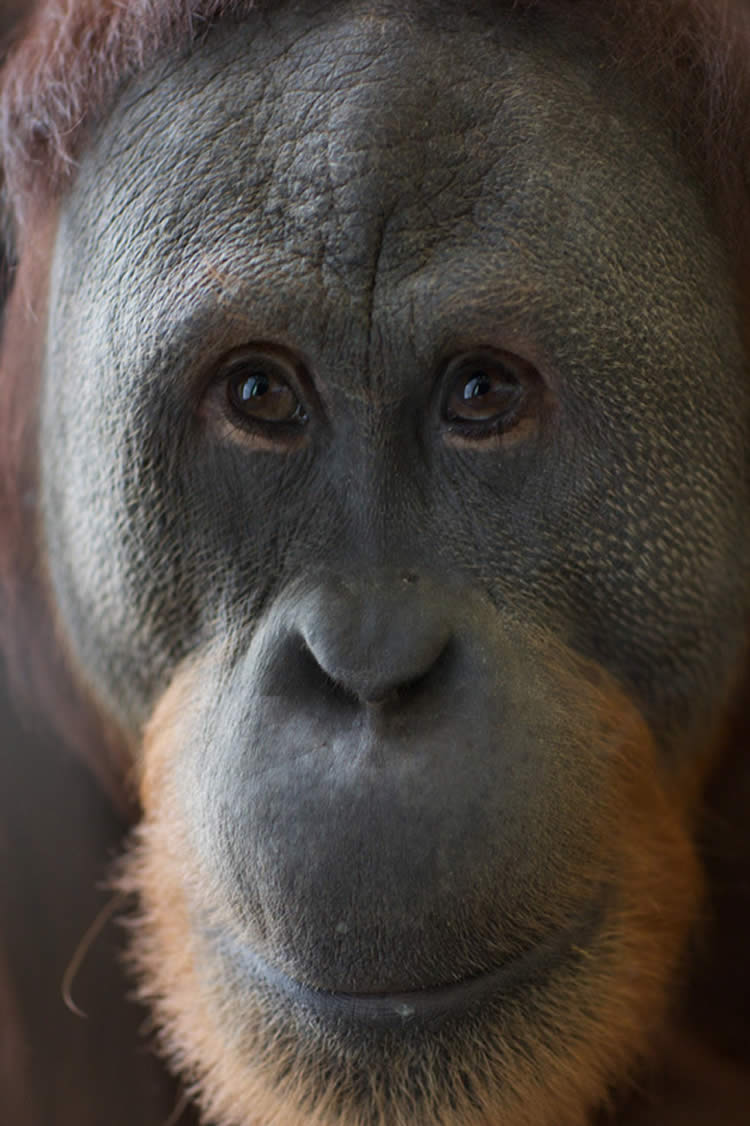Summary: Rocky the Orangutan may help researchers better understand how human speech evolved from the time of the great apes.
Source: Max Planck Institute.
Orangutan Rocky could provide the key to understanding how speech in humans evolved from the time of the ancestral great apes.
Previously it was thought that great apes – our closest relatives – could not learn to produce new sounds and because speech is a learned behaviour it could not have originated from them. In an imitation “do-as-I-do” game, eleven-year-old Rocky, who was eight at the time of the research, was able to copy the pitch and tone of sounds made by researchers to make vowel-like calls. The discovery, led by Durham University, UK, shows that orangutans could have the ability to control their voices. Alexander Mielke of the Max Planck Institute for Evolutionary Anthropology in Leipzig, Germany, was part of the international research team.

During a study which was conducted in April and May 2012 in the Indianapolis Zoo in the USA, where orangutan Rocky is currently housed, a researcher made random sounds with variations in the tone or pitch of her voice which Rocky then mimicked. The research team compared these sounds against the largest available database of orangutan calls collected from over 12,000 hours of observations of more than 120 orangutans from 15 wild and captive populations. They were able to conclude that the sounds made by Rocky were different compared to the sounds on the database, showing that he was able to learn new sounds and control the action of his voice in a “conversational” context.
“It’s not clear how spoken language evolved from the communication systems of the ancestral great apes”, says lead author Adriano Lameira, who was not a member of Durham University staff at the time of the research but joined the Department of Anthropology in 2015. “Instead of learning new sounds, it has been presumed that sounds made by great apes are driven by arousal over which they have no control, but our research proves that orangutans have the potential capacity to control the action of their voices.”
“This indicates that the voice control shown by humans could derive from an evolutionary ancestor with similar voice control capacities as those found in orangutans and in all great apes more generally”, says Lameira. “This opens up the potential for us to learn more about the vocal capacities of early hominids that lived before the split between the orangutan and human lineages to see how the vocal system evolved towards full-blown speech in humans.”
The findings that Rocky learned a vocalisation which is not species-specific, and that he can manipulate his vocal apparatus to copy the sounds presented to him, do not only teach us about the evolution of language. They also have implications for our understanding of how flexible and complex the communication systems of other great apes can be, and the role of vocal communication in their everyday life”, says co-author Alexander Mielke, in the Department of Primatology, at the Max Planck Institute for Evolutionary Anthropology.
Mielke was involved in the automated vocal analysis of Rocky’s calls and established how accurately they matched the model vocalisation. To this aim he adapted the automated voice recognition software that he had originally developed for recognizing the calls of blue monkeys, another primate species.
This study builds on a previous study, led by Lameira when he was based at the University of Amsterdam. In that study, published in January 2015, it was reported that a female orangutan called Tilda at Cologne Zoo, in Germany, was able to make sounds comparable to human consonant and vowel-like calls at the same rhythm and pace as human speech.
Source: Sandra Jacob – Max Planck Institute
Image Source: This NeuroscienceNews.com image is credited to Indianapolis Zoo, Indiana, USA.
Video Source: The video is credited to max Planck Society.
Original Research: Full open access research for “Vocal fold control beyond the species-specific repertoire in an orang-utan” by Adriano R. Lameira, Madeleine E. Hardus, Alexander Mielke, Serge A. Wich and Robert W. Shumaker in Scientific Reports. Published online July 29 2016 doi:10.1038/srep30315
[cbtabs][cbtab title=”MLA”]Max Planck Institute. “Voice Control in Orangutan Gives Clues to Early Human Speech.” NeuroscienceNews. NeuroscienceNews, 1 August 2016.
<https://neurosciencenews.com/human-speech-development-4762/>.[/cbtab][cbtab title=”APA”]Max Planck Institute. (2016, August 1). Voice Control in Orangutan Gives Clues to Early Human Speech. NeuroscienceNew. Retrieved August 1, 2016 from https://neurosciencenews.com/human-speech-development-4762/[/cbtab][cbtab title=”Chicago”]Max Planck Institute. “Voice Control in Orangutan Gives Clues to Early Human Speech.” https://neurosciencenews.com/human-speech-development-4762/ (accessed August 1, 2016).[/cbtab][/cbtabs]
Abstract
Vocal fold control beyond the species-specific repertoire in an orang-utan
Vocal fold control was critical to the evolution of spoken language, much as it today allows us to learn vowel systems. It has, however, never been demonstrated directly in a non-human primate, leading to the suggestion that it evolved in the human lineage after divergence from great apes. Here, we provide the first evidence for real-time, dynamic and interactive vocal fold control in a great ape during an imitation “do-as-I-do” game with a human demonstrator. Notably, the orang-utan subject skilfully produced “wookies” – an idiosyncratic vocalization exhibiting a unique spectral profile among the orang-utan vocal repertoire. The subject instantaneously matched human-produced wookies as they were randomly modulated in pitch, adjusting his voice frequency up or down when the human demonstrator did so, readily generating distinct low vs. high frequency sub-variants. These sub-variants were significantly different from spontaneous ones (not produced in matching trials). Results indicate a latent capacity for vocal fold exercise in a great ape (i) in real-time, (ii) up and down the frequency spectrum, (iii) across a register range beyond the species-repertoire and, (iv) in a co-operative turn-taking social setup. Such ancestral capacity likely provided the neuro-behavioural basis of the more fine-tuned vocal fold control that is a human hallmark.
“Vocal fold control beyond the species-specific repertoire in an orang-utan” by Adriano R. Lameira, Madeleine E. Hardus, Alexander Mielke, Serge A. Wich and Robert W. Shumaker in Scientific Reports. Published online July 29 2016 doi:10.1038/srep30315






